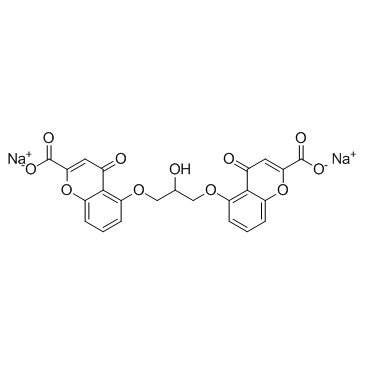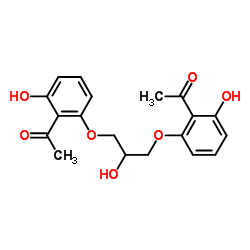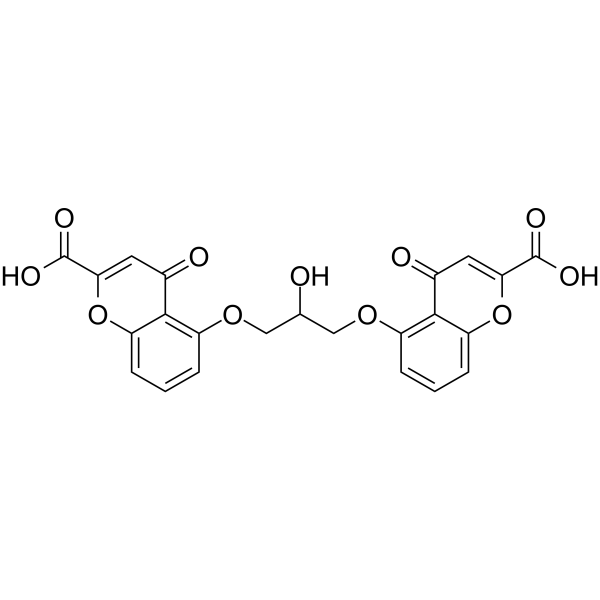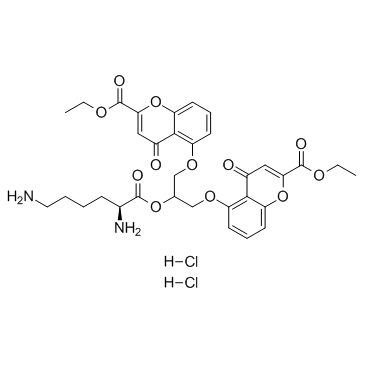Cromolyn (sodium)

Cromolyn (sodium) structure
|
Common Name | Cromolyn (sodium) | ||
|---|---|---|---|---|
| CAS Number | 15826-37-6 | Molecular Weight | 512.330 | |
| Density | N/A | Boiling Point | 752.3ºC at 760 mmHg | |
| Molecular Formula | C23H14Na2O11 | Melting Point | 241-2420C (dec) | |
| MSDS | Chinese USA | Flash Point | 263.9ºC | |
| Symbol |

GHS07 |
Signal Word | Warning | |
Use of Cromolyn (sodium)Cromolyn sodium is an antiallergic drug.Target: Calcium ChannelCromolyn sodium is a chromone complex that acts by inhibiting the release of chemical mediators from sensitized mast cells. It is used in the prophylactic treatment of both allergic and exercise-induced asthma, but does not affect an established asthmatic attack.Pretreatment of IIR mice with Cromolyn sodium prior to ischemia exhibited no changes of ET-1 levels, injury score and inflammation (P>0.05, PreCr vs. M groups). In conclusion, administration of Cromolyn sodium after reperfusion, but not prior to ischemia, attenuates IIRI by downregulating ET-1 and suppressing sustained MC activation [1]. cromolyn sodium has a role in the prevention of Chronic lung disease(CLD). Cromolyn sodium cannot be recommended for the prevention of CLD in preterm infants [2]. |
| Name | disodium cromoglycate |
|---|---|
| Synonym | More Synonyms |
| Description | Cromolyn sodium is an antiallergic drug.Target: Calcium ChannelCromolyn sodium is a chromone complex that acts by inhibiting the release of chemical mediators from sensitized mast cells. It is used in the prophylactic treatment of both allergic and exercise-induced asthma, but does not affect an established asthmatic attack.Pretreatment of IIR mice with Cromolyn sodium prior to ischemia exhibited no changes of ET-1 levels, injury score and inflammation (P>0.05, PreCr vs. M groups). In conclusion, administration of Cromolyn sodium after reperfusion, but not prior to ischemia, attenuates IIRI by downregulating ET-1 and suppressing sustained MC activation [1]. cromolyn sodium has a role in the prevention of Chronic lung disease(CLD). Cromolyn sodium cannot be recommended for the prevention of CLD in preterm infants [2]. |
|---|---|
| Related Catalog | |
| References |
| Boiling Point | 752.3ºC at 760 mmHg |
|---|---|
| Melting Point | 241-2420C (dec) |
| Molecular Formula | C23H14Na2O11 |
| Molecular Weight | 512.330 |
| Flash Point | 263.9ºC |
| Exact Mass | 512.033142 |
| PSA | 179.37000 |
| Storage condition | Refrigerator, Under Inert Atmosphere |
| Stability | Hygroscopyc |
CHEMICAL IDENTIFICATION
HEALTH HAZARD DATAACUTE TOXICITY DATA
|
| Symbol |

GHS07 |
|---|---|
| Signal Word | Warning |
| Hazard Statements | H315-H319-H335 |
| Precautionary Statements | P305 + P351 + P338 |
| Personal Protective Equipment | dust mask type N95 (US);Eyeshields;Gloves |
| Hazard Codes | Xi: Irritant; |
| Risk Phrases | R36/37/38 |
| Safety Phrases | S26-S36 |
| RIDADR | 3249 |
| WGK Germany | 2 |
| RTECS | DJ2380000 |
| Packaging Group | III |
| Hazard Class | 6.1(b) |
| HS Code | 2932999099 |
| HS Code | 2932999099 |
|---|---|
| Summary | 2932999099. other heterocyclic compounds with oxygen hetero-atom(s) only. VAT:17.0%. Tax rebate rate:13.0%. . MFN tariff:6.5%. General tariff:20.0% |
|
Chronic pelvic allodynia is mediated by CCL2 through mast cells in an experimental autoimmune cystitis model.
Am. J. Physiol. Renal Physiol. 308(2) , F103-13, (2015) The cause of chronic pelvic pain in interstitial cystitis/painful bladder syndrome (IC/PBS) remains unclear; autoimmunity is a possible etiology. We have recently shown that injection of a single immu... |
|
|
Psychological stress and corticotropin-releasing hormone increase intestinal permeability in humans by a mast cell-dependent mechanism.
Gut 63(8) , 1293-9, (2014) Intestinal permeability and psychological stress have been implicated in the pathophysiology of IBD and IBS. Studies in animals suggest that stress increases permeability via corticotropin-releasing h... |
|
|
Inhibition of mast cell-derived histamine secretion by cromolyn sodium treatment decreases biliary hyperplasia in cholestatic rodents.
Lab. Invest. 94(12) , 1406-18, (2014) Cholangiopathies are characterized by dysregulation of the balance between biliary growth and loss. We have shown that histamine (HA) stimulates biliary growth via autocrine mechanisms. To evaluate th... |
| Disodium 5,5'-[(2-hydroxypropane-1,3-diyl)bis(oxy)]bis(4-oxo-4H-chromene-2-carboxylate) |
| Cromoglycate Cromoglycic acid |
| Irtan |
| CROMOLYN SODIUM |
| EINECS 239-926-7 |
| Sodium cromoglicate |
| Disodium 5,5'-[(2-hydroxy-1,3-propanediyl)bis(oxy)]bis(4-oxo-4H-chromene-2-carboxylate) |
| OPTICROM |
| Nalcrom |
| Rynacrom |
| Nalcron |
| Cromolyn sodium salt |
| Cromovet |
| Disodium Cromoglycate Hydrate |
| DSCG |
| INTAL |
| Alerion |
| Sodium cromoglycate |
| Opticron |
| Cromolyn Disodium Salt |
| Lomudal |
| Lomusol |
| Vividrin |
| Colimune |
| 4H-1-benzopyran-2-carboxylic acid, 5,5'-[(2-hydroxy-1,3-propanediyl)bis(oxy)]bis[4-oxo-, disodium salt |
| 4H-1-Benzopyran-2-carboxylic acid, 5,5'-[(2-hydroxy-1,3-propanediyl)bis(oxy)]bis[4-oxo-, sodium salt (1:2) |
| Disodium chromoglycate |
| Sofro |
| Cromoglycate,Cromoglycic acid,Cromolyn sodium salt |
| Lomuspray |
| Fivent |
| MFCD00057744 |
| Gastrofrenal |
| Allergocrom |
| Introl |
| Cromolyn Disodium Salt Hydrate |
| CROMOPTIC |
| Dinatrium-5,5'-[(2-hydroxypropan-1,3-diyl)bis(oxy)]bis(4-oxo-4H-chromen-2-carboxylat) |
| disodium cromoglycate |
| disodium,5-[3-(2-carboxylato-4-oxochromen-5-yl)oxy-2-hydroxypropoxy]-4-oxochromene-2-carboxylate |
| Cromolyn (sodium) |
 CAS#:16150-44-0
CAS#:16150-44-0 CAS#:16150-45-1
CAS#:16150-45-1 CAS#:16110-51-3
CAS#:16110-51-3 CAS#:110816-78-9
CAS#:110816-78-9![dimethyl 5,5'-[(2-hydroxytrimethylene)bis(oxy)]bis[4-oxo-4H-1-benzopyran-2-carboxylate] structure](https://image.chemsrc.com/caspic/196/51471-26-2.png) CAS#:51471-26-2
CAS#:51471-26-2
